한국시장에서의 월마트와 이마트 분석- 월마트 실패사례(영문)
 등록일 / 수정일
등록일 / 수정일 페이지 / 형식
페이지 / 형식 자료평가
자료평가 구매가격
구매가격
- 2005.04.08 / 2019.12.24
- 28페이지 /
 doc (MS워드 2003이하)
doc (MS워드 2003이하) 



 1건 (구매금액의 3%지급)
1건 (구매금액의 3%지급)- 3,100원
최대 20페이지까지 미리보기 서비스를 제공합니다.
자료평가하면 구매금액의 3%지급!
 1
1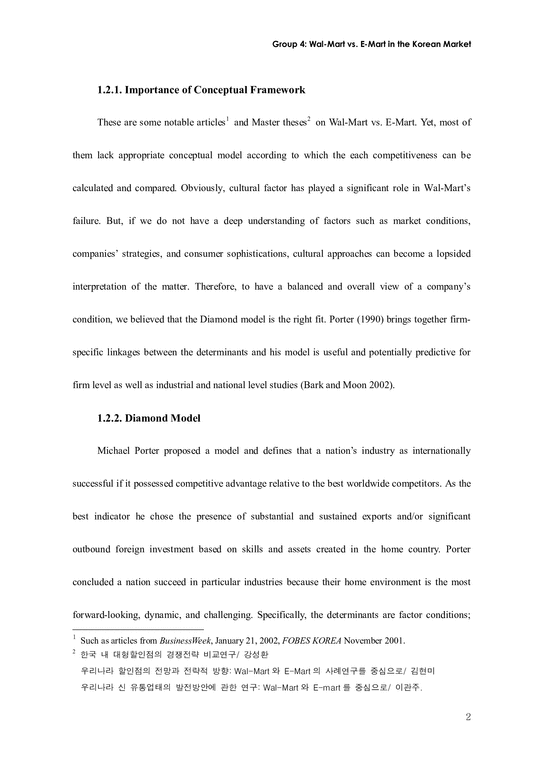 2
2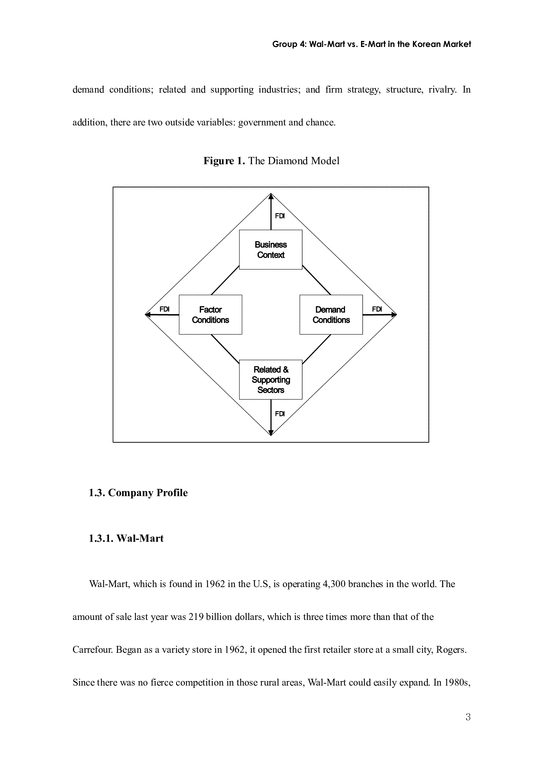 3
3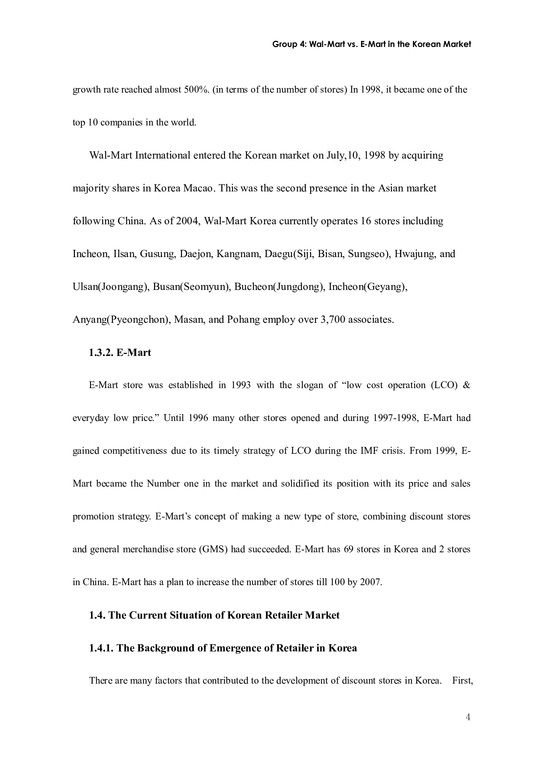 4
4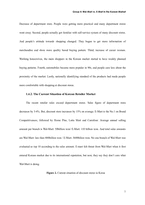 5
5 6
6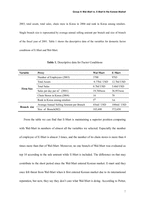 7
7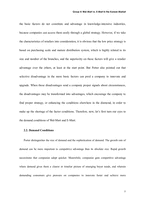 8
8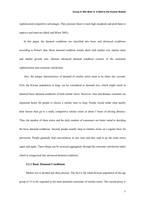 9
9 10
10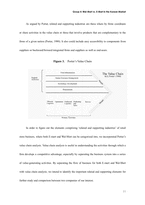 11
11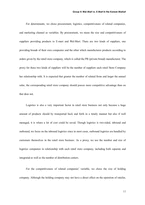 12
12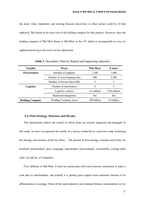 13
13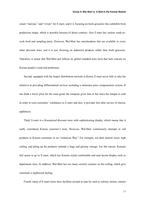 14
14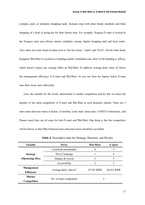 15
15 16
16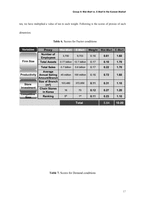 17
17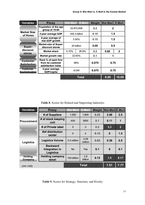 18
18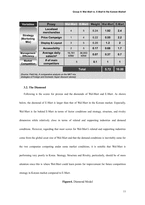 19
19 20
20
추천 연관자료
- 목차
-
1. Introduction
1.1. Background
1.2.1. Importance of Conceptual Framework
1.2.2. Diamond Model
1.3. Company Profile
1.3.1. Wal-Mart
1.3.2. E-Mart
1.4. The Current Situation of Korean Retailer Market
1.4.1. The Background of Emergence of Retailer in Korea
1.4.2. The Current Situation of Korean Retailer Market
2. Diamond Variables and Descriptive Data of the Wal-Mart and E-Mart
2.1. Factor Conditions
2.2. Demand Conditions
2.2.1 Basic Demand Conditions
2.2.2 Advanced Demand Conditions
2. 3. Related and Supporting Industries
2.4. Firm Strategy, Structure and Rivalry
3. Empirical Results and the Diamond
3.1. Score calculation and proxies
3.2. The Diamond
4. Hofstede’s cultural dimension model and Strategic Implication
4.1. Hofstede’s cultural dimension model
4.2. Strategic Implication of Hofstede's Model
5. Failure of Wal-Mart's Strategy in Korea and Propositions
5.1.1. Failed Strategy
5.1.2. Wal-Mart’s Perspective on Current Situation
5.1.3. Proposition for Wal-Mart
- 본문내용
-
1. Introduction
1.1. Background
American Wal-Mart is the number one retailer in the world. Yet, in the Korean market, its performance is not very good. In a recent performance survey, it ranked at fifth outstripped by number one Korean E-Mart in almost every aspect. What made this possible? Is it just the outcome of cultural misunderstanding, or the outcome of different marketing strategies of the two? In this paper, we will look into the competitive factors of each company and try to draw a comparison between them. Among various models, which address the competitiveness of firms, we will use the general diamond model (Porter, 1990) in order to assess the competitiveness of Wal-Mart and E-Mart. Also, to incorporate the obvious cultural factors, we will used Hofstede’s(1983) cultural dimension model. Finally, we will give the several propositions to make the Wal-Mart more competitive in the Korean market.
1.2.1. Importance of Conceptual Framework
These are some notable articles and Master theses on Wal-Mart vs. E-Mart. Yet, most of them lack appropriate conceptual model according to which the each competitiveness can be calculated and compared. Obviously, cultural factor has played a significant role in Wal-Mart’s failure. But, if we do not have a deep understanding of factors such as market conditions, companies’ strategies, and consumer sophistications, cultural approaches can become a lopsided interpretation of the matter. Therefore, to have a balanced and overall view of a company’s condition, we believed that the Diamond model is the right fit. Porter (1990) brings together firm-specific linkages between the determinants and his model is useful and potentially predictive for firm level as well as industrial and national level studies (Bark and Moon 2002).
- 참고문헌
-
Hofstede, Geert, 1983, “The Cultural Relativity of Organizational Practices and Theories,” Journal of International Business Studies Fall: 75-89.
Hofstede, Geert, 1997, Cultures and Organizations: Software of the Mind, New York: McGraw-Hill.
Moon, Hwy-Chang, Alan M. Rugman and Alain Verbeke, 1995, “The generalized double diamond approach to the global competitiveness,” in Alan Rugman, Julien Van Den Broeck and Alain Verbeke, eds. Research in global strategic management: Beyond the diamond. Greenwich CT: JAI Press 5, pp.97-114.
Moon, Hwy-Chang, Alan M. Rugman and Alain Verbeke, 1998, “A generalized double diamond approach to the global competitiveness of Korea and Singapore,” International Business Review 7: 135-150.
Moon, Hwy-Chang and Eun-Kyung Choi, 2001, “Cultural Impact on National Competitiveness,” Journal of International and Area Studies 8(2): 21-36.
Porter, Michael E., 1990, The Competitive Advantage of Nations, New York: The Free Press.
Rugman, Alan M. and J. R. D’Cruz,
자료평가





- ...
- wkdtpsd***
(2008.12.09 17:40:06)
오늘 본 자료
더보기

최근 판매 자료
- [노사관계론]모의교섭 절차와 방법
- [마케팅성공사례] 화장품 `미샤` 마케팅분석
- [호텔경영] 신라&메리어트 호텔의 조직 구성도
- POSCO 포스코 사회적책임완수위한 윤리경영사례분석
- 경쟁사 분석을 통한 자사의 경쟁력 방안
- CJ CGV 기업분석과 CGV 마케팅 4P,SWOT,STP전략분석및 CGV 경쟁사전략(롯데시네마,메가박스)과 비교분석 PPT레포트
- 도브 Dove 브랜드분석과 SWOT분석및 도브 마케팅과 광고전략 연구 - 도브 한국시장 전략연구 레포트
- [국제무역론] 생산요소의 국제이동
- CHIP4 추진배경 및 가입에 따른 문제점 [CHIP4,반도체,CHIP,시스템반도체,미중]
- [경영전략] 넥센타이어의 기업전략 분석
저작권 관련 사항 정보 및 게시물 내용의 진실성에 대하여 레포트샵은 보증하지 아니하며, 해당 정보 및 게시물의 저작권과 기타 법적 책임은 자료 등록자에게 있습니다. 위 정보 및 게시물 내용의 불법적 이용, 무단 전재·배포는 금지됩니다. 저작권침해, 명예훼손 등 분쟁요소 발견시 고객센터에 신고해 주시기 바랍니다.









